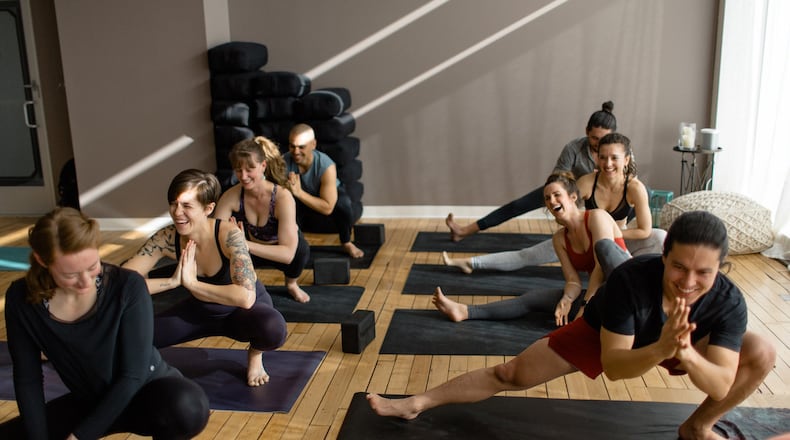“Our clients are in very tight quarters,” Reynolds said, “but even more so than like a restaurant or a shop. We put people in a room with inches in between their mats, and we basically ask them to breathe really intentionally for 60 to 75 minutes so it just felt like honestly too much — a breeding ground for disaster.”
Reynolds, a Beavercreek High School graduate who opened Speakeasy Yoga in 2016, closed the location at 510 E. Third St. and the studio at 204 Wayne Ave. in Dayton on the night March 15, not long after Gov. Mike DeWine closed restaurants and bars across the state. A day later, he forced other non-essential businesses across the state to shut down.
Planning for keeping Speakeasy Yoga afloat during the COVID-19 crisis started immediately. Reynolds’ husband, Ben Rivet, works as an audio/visual engineer and knew how to set up a system for Reynolds to start online classes.
“We ran the first live-stream classes while we were still open, actually, on Sunday the 15th,” Reynolds said, “and we had we had cut down to half capacity that weekend because I figured we at least needed to do something. But even when I was teaching my class on Sunday morning and there were 22 people instead of 48 people, it just felt wrong. I had a feeling that we needed to stop and so I was going back and forth with my partner and my husband and the teachers.”
» MORE COVERAGE: How respiratory therapists are leading the fight against COVID-19?
On March 16, Speakeasy Yoga started broadcasting classes live three or four times a day through its website. Clients who pay by the month or have an annual membership get the classes with their membership. Speakeasy started offering passes for $40 a month for unlimited online classes as well as a $10 option for people who wanted to drop in for a single class.
“It’s worked really well,” Reynolds said. “We’re seeing the same attendance per day, if not more. We typically have six to eight classes in a day on average. Now we only have three to five classes per day, and we’re still seeing over 100 people attend these classes virtually in a day, so we feel extremely supported.”
Reynolds basically created a broadcast television station within 48 hours of deciding to go online. The content isn’t pre-recorded. It’s all live video of Reynolds and her team.
“I’ve been explaining to everyone that it’s going to take us a few weeks to build up a catalogue of content,” she said, “before we can then go and try to put together an on-demand page with a whole new paywall. My business partner (Seth Hummel) and my husband are working on that.”
» STILL RUNNING: Dayton RTA takes pride in continuing operations
Like many small-business owners in Dayton and around the country, Reynolds is preparing herself for the long haul. There’s no telling when she’ll be able to welcome people back to the studio, and when they can return, she expects things to feel different.
“I think people are actually going to suffer some serious PTSD from this and be a little bit hesitant about the things that they did before with the scare of a resurgence of the virus,” Reynolds said. “So we’re trying to be really be sensitive to that in the content we’re creating and trying to allow everyone to see the silver lining in this, that they get this opportunity to develop a whole home practice and strengthen that.”
For Speakeasy Yoga, the silver lining is that it has given them time to get the online classes going.
“With all the work that we do day to day, that there was no way that we would have been able to get this up and running, even within you know a couple months time,” she said. “It probably would have taken us at least half a year, if not the rest of this year to to actually nail down the time where we could put this into play and figure it out while we were running 45 regular in-person classes a week.”
About the Author

